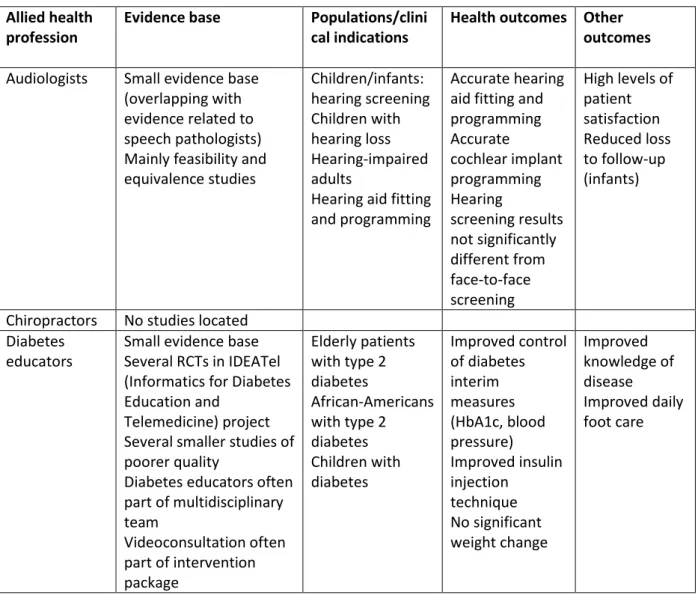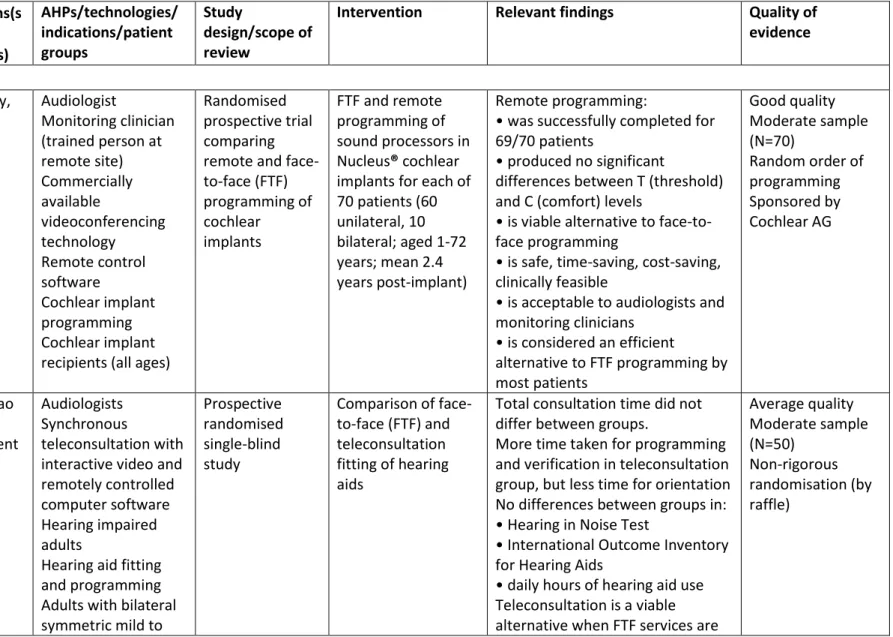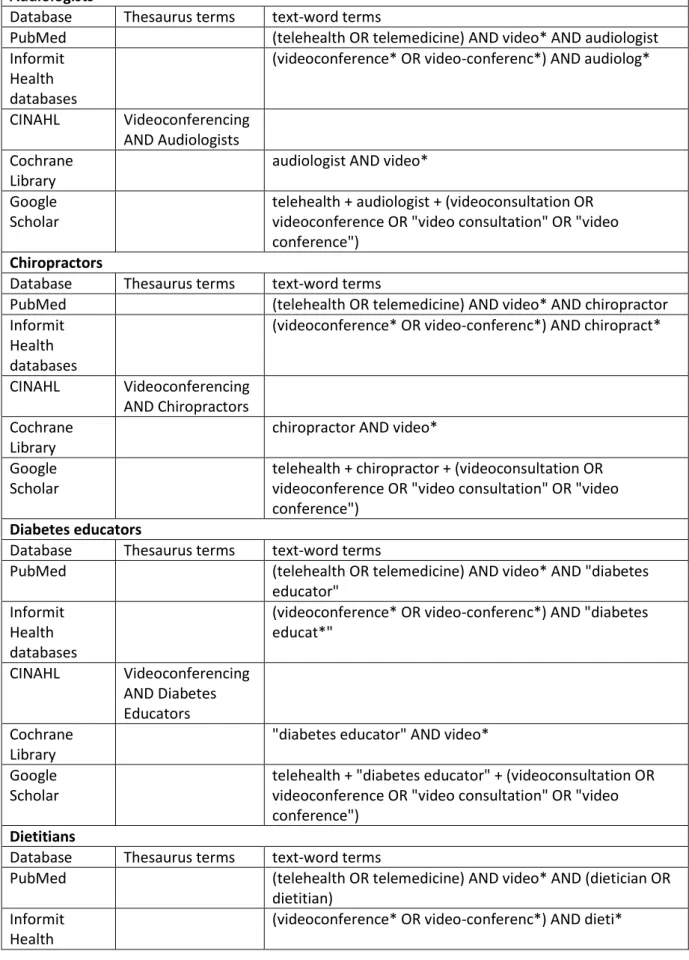Health outcomes Other outcomes Audiologists Little evidence base. overlapping with evidence related to speech pathologists). Optometrists Very little evidence base Very few studies, small sample sizes; mainly in developing countries More evidence related to teleophthalmology that may be applicable. Although the evidence base regarding the use of video consultations by AHPs is relatively limited, and for some AHPs there is little or no published evidence, results are generally promising in terms of patient and provider satisfaction.

Background
Medicare rebates
Aims
Definitions and scope
In contrast to a systematic review, which is extensive but time-consuming and resource-intensive, a rapid review aims to provide a targeted synthesis of research evidence relevant to a specific policy issue within a short time frame. Most studies were of poor quality, mainly due to lack of control groups, non-randomisation, small sample sizes and short follow-up periods.
Findings
According to the authors of a systematic review of telehealth (p. 3),10 "There are still significant gaps in the evidence base between where telemedicine is used and where its use is supported by high-quality evidence".
1 Audiologists
A US investigation of cochlear implant recipients' speech perception in videoconferencing, comparing the performance of two different video systems, found that speech perception was better when assessed in a sound-treated booth.16 One study Another American compared video-based telehealth and face-to-face assessment of cochlear implant patients for research and clinical measures, including hearing threshold and speech perception.17 The authors concluded that telehealth was a viable option. , but that further research was needed. Video-based telehealth was seen as particularly useful for infants who may not return for assessment (p. 117). In summary, audiologist video consultation has been found to be a viable option for programming hearing aids and cochlear implants, for testing the hearing and speech perception of cochlear implant recipients, and for testing children's hearing.
2 Chiropractors
Early evaluation of the data showed positive results in terms of reduced losses to follow-up and 'increased efficiency, effectiveness and equity';. In the US, a feasibility study of hearing screening of elementary school children via video consultation found that overall results were not significantly different from face-to-face screening.19 However, this was a small study of mostly normal-hearing children, limit the generalization. Several non-systematic reviews have discussed a variety of video-based teleaudiology initiatives and issues.18,22 Common themes include the potential for teleaudiology to increase access to services, which is already happening, and potential technical issues. including video limited bandwidth (which is less and less of a problem).
3 Diabetes educators
The first study examined the effectiveness of videoconferencing and remote monitoring for 47 inner-city African Americans diagnosed with type 2 diabetes and able to read at an eighth-grade level or higher.32 Compared to controls, participants had nearly five times the more likely to achieve target blood glucose (HbA1c) levels (7% or less), and more likely to achieve a healthy body mass index (BMI). Its content includes comprehensive education in diabetes self-management; monitoring blood sugar, blood pressure and lipids; motivational conversation; and individual treatment plans. Both groups improved on several indicators, including control of two or more risk factors, patient satisfaction, self-reported blood glucose monitoring, and dietary adherence.
4 Dietitians
In summary, although there is little good quality evidence supporting dietary video consultation, there is evidence of benefits for diabetes, obesity and parenteral nutrition.
5 Exercise physiologists
6 Midwives
Four common scenarios (having a painful breast, correct positioning at the breast, preparing bottles with formula and general postnatal health problems) were included in the questionnaire. Lindberg concluded that videoconferencing can act as a bridge between parents and midwives in the postpartum period.49. In the study of parents' experiences, nine couples or parents completed questionnaires immediately after 23 video conference sessions and participated in semi-structured interviews.51 They.
7 Nurse practitioners
There was a statistically significant decrease in the MI group (p = 0.015) but not in the lifestyle education group. In the video consultation group, a telemedicine unit was made available in the school nurse's office for videoconferencing for monthly videoconferencing between the child, the school nurse and a nurse from the diabetes team. HbA1c values decreased in the video consultation group from baseline to six months, but increased in the usual care group (p < 0.02).
8 Occupational therapists
The results showed that video assessment is effective and not inferior to face-to-face assessment. Recently, video and face-to-face wheelchair seat assessment and adjustment were compared for 30 clients in Alberta.70 Ten clients were assessed via video consultation. In the USA (Kentucky), the acceptability of a video-based pre-operative education program for rural total joint replacement patients was evaluated.72 The lectures, led by an occupational therapist and a physical therapist, are designed to provide information to help patients have realistic expectations about the surgery. .
9 Optometrists
An Australian study of telehealth use in a 441-bed long-term care facility in Brisbane found that ophthalmology consultations were the fifth most common service category.79 No efficacy data were available. In summary, there is little relevant evidence on the use of video consultation by optometrists, but some literature on teleophthalmology is relevant. A few studies in India and one in Australia provide weak evidence for the feasibility of teleoptometry/teleophthalmology in current clinical practice.
10 Orthoptists
11 Osteopaths
12 Physiotherapists
In the USA, an equivalence trial of video-based assessment was conducted with 26 people with a history of stroke, who were simultaneously assessed face-to-face and remotely on the European Stroke Scale (ESS) and the Functional Reach Test (FRT). .85 When the face-to-face physical therapist directed patients, equivalent values were obtained in more than 90 percent of patients for FRT and for all ESS components except gait (83%) and maintenance of leg position (85%). An Australian study compared remote video-based examination and face-to-face examination of musculoskeletal elbow disorders. 86 Ten participants were examined simultaneously by two final-year physiotherapy students, one remotely. In summary, there is reasonable evidence to support the use of video-based physiotherapy in a range of settings, including clients' homes.
13 Podiatrists
Telepodiatry was preferred by 87 percent of residents, and it was acceptable to the pediatrician in almost 80 percent of cases. A very small Australian study of the use of videoconferencing for allied health services, including paediatrics, for residents of high-care aged care facilities found no difference in the time required for a videoconferencing assessment compared to an in-person assessment by a pediatrician.37 However, there was patient satisfaction was higher with face-to-face assessment and most AHPs preferred this method. In summary, there is weak evidence from Australia and Hong Kong on the acceptability of pediatric videoconsultation.
14 Psychologists
One of the better quality trials in the literature is a randomized non-inferiority trial. According to Pesamao et al. there have been no rigorous analyzes of the effectiveness and cost-effectiveness of video-consultation as a treatment delivery strategy, so more rigorous trials have been recommended. There is much evidence of benefit and little or no evidence of harm, but the quality of most evidence is poor.
15 Speech pathologists/therapists
A relatively rigorous RCT focusing on anger management therapy found few significant differences compared to face-to-face therapy. Theodoros also co-authored an earlier review, which was much more cautious and emphasized the weakness of the research.114 Her review from 2012 drew on a significantly better evidence base. In a review of the reliability of Internet-based videoconferencing for assessment of motor speech disorders compared to face-to-face assessment, four of the five studies that met the selection criteria were conducted at the University of Queensland.115 Videoconferencing was found to be reasonably reliable for assessment of apraxia of speech in adults116 and motor speech disorders in adults.117.
Another prominent research site is the Speech Pathology Service of the National Rehabilitation Hospital in Washington. An equivalence study found that assessing the functional communication of stroke patients using videoconferencing is equivalent to face-to-face assessment.118 Similarly, a comparison of performance on the Story Retelling Procedure found no significant difference between the assessment video-based and face-to-face. .119. Researchers in the United States diagnosed neurogenic communication disorders using closed-circuit television, computer-controlled video, and traditional face-to-face methods and found no significant differences among the three methods.120,121.
A very small Australian study of the use of videoconferencing for allied health services for residents of a high-care residential aged care facility found no difference in time taken for videoconferencing assessment compared to face-to-face assessment by a speech pathologist .37 However, patient satisfaction was higher with face-to-face assessment, and a majority of AHPs preferred that modality. There have been a few small studies looking at dysphagia (swallowing problems, often as a result of laryngectomy) which suggest that assessment via video conferencing may be possible.113 Again, much of the research has been done in Australia. This includes an equivalence trial in which 40 patients with dysphagia were assessed simultaneously by two speech-language pathologists, one face-to-face and the other via an Internet-based videoconferencing telerehabilitation system.122 Dysphagia status was assessed using a clinical swallowing examination (CSE). protocol.
A patient satisfaction survey found that while 92 percent of patients felt they would be comfortable receiving services via telerehabilitation, 45 percent preferred a traditional face-to-face assessment.
Conclusion
Targeting using telemedicine in rural underserved older adults with diabetes: lessons from the informatics for diabetes education and telemedicine project. Using telehealth to provide diabetes care to patients in rural Montana: results from the Promoting Realistic Individual Self-Management Program. Journal of Telemedicine and Telecare, 9, S52-S54 www.jtt.rsmjournals.com/content/9/suppl_1/52.short 39 Castelnuovo G, Manzoni GM, Corti S, Cuzziol P, Villa V, Molinari E.
Archives of Family Medicine, 40-45 www.mrw.interscience.wiley.com/cochrane/cleed/articles/NHSEED frame.html. Advances in Transplantation (Aliso Viejo, California), 97-102 www.mrw.interscience.wiley.com/cochrane/clcentral/articles/649/CN-00649649/frame.html. Alexandria, VA: American Physical Therapy Association www.findthatdoc.com/search-70078911-hPDF/download-documents-telehealth-pdf.htm.
Sacramento, California: California Telemedicine and Health Center www.umtrc.org/resources/getting-started-guides/ctec-a- literature-review-on-clinical-outcomes-cost-effectiveness-and-reimbursement-for-. 34;Can You See What I'm Saying?": An Action Study, Mixed Methods Evaluation of Telepsychology in Rural Western Australia. Telemedicine for Anger Management Therapy in a Rural Population of War Veterans with Posttraumatic Stress Disorder: A randomized non-inferiority trial.
The usefulness of videoconferencing to provide innovative psychological treatments for rural cancer patients: results from a pilot study.
Appendix
Pilot study of diabetes education delivered via face-to-face g videoconferencing (FTF) in the country. Pilot study of diabetes education delivered via videoconferencing versus face-to-face (FTF) delivery in the country. Poor quality of pilot study Very small sample (N= 7 midwives) Small sample (N=23) of videoconferencing sessions, with 20 reports (87%).
Feasibility study of assessment of RACF residents in high care, comparing face-to-face (FTF) assessment with video consultation assessment.

